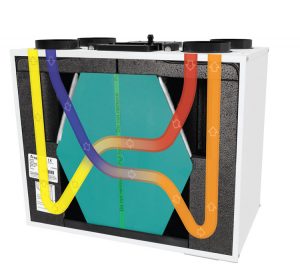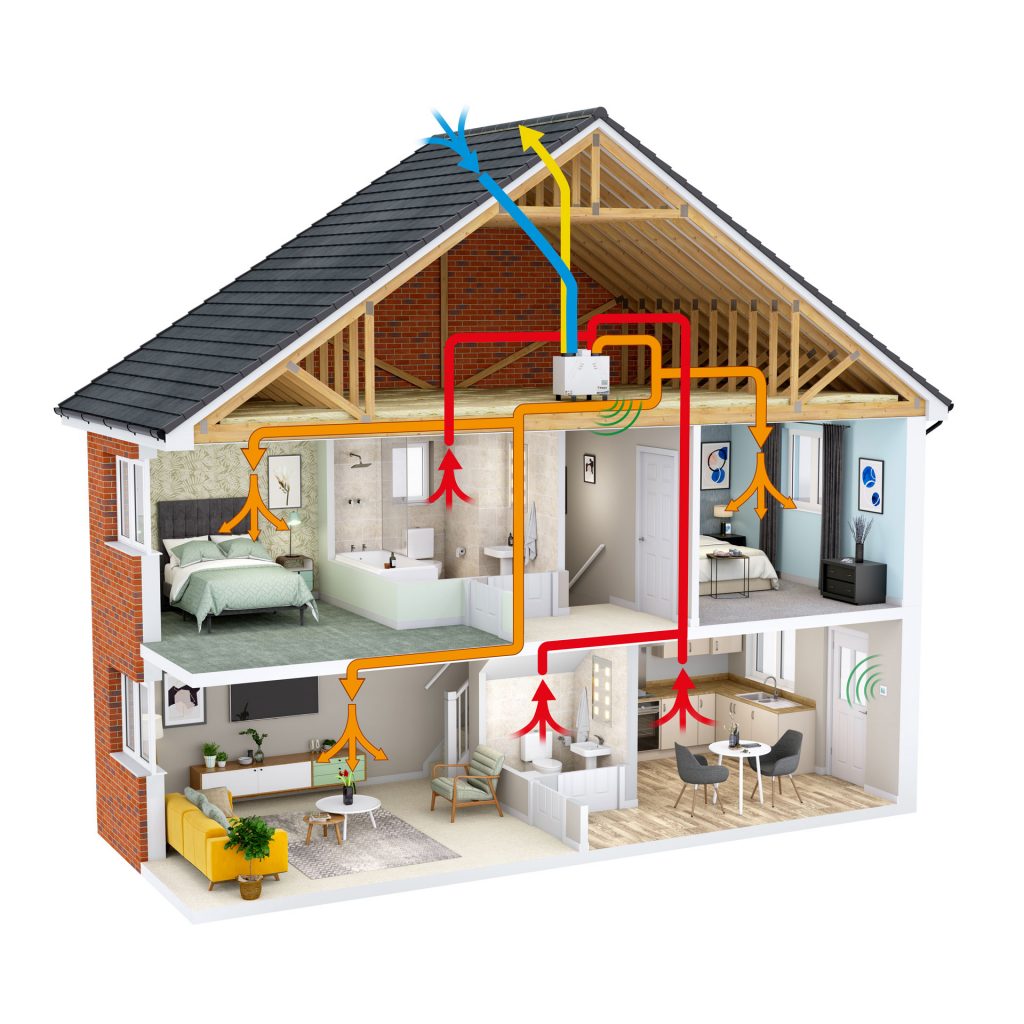Resources
Resource Type
What is MVHR?
Mechanical Ventilation with Heat Recovery (MVHR) is a centrally located continuously running mechanical supply and extract fan which extracts air via ducts from moisture producing areas or “wet rooms”, such as kitchens and bathrooms, to remove odours and excessive humidity.  This air is passed over a heat exchanger, which transfers a high proportion of the heat of the extracted air to the incoming air, which is then distributed to the habitable rooms via ducts.
This air is passed over a heat exchanger, which transfers a high proportion of the heat of the extracted air to the incoming air, which is then distributed to the habitable rooms via ducts.
Whole building ventilation is maintained by a constant flow of air between input and extract points. A boost facility provides rapid extraction when necessary to remove higher levels of pollutants. As an alternative, every room may have an individual unit as opposed to a centrally located and ducted unit. No background ventilators are required in this System.
Watch: How Mechanical Ventilation with Heat Recovery (MVHR) works
All models in the Domestic Mechanical Ventilation with Heat Recovery range are designed and manufactured by Titon. All models perform to Energy Savings Trust Best Practice levels and many are the most efficient units for their size available in the UK. All have been designed to give benefits to specifiers, contractors and end users.
Where can it be used?
Mechanical ventilation with heat recovery is suitable for use houses and flats or apartments, usually in premium developments due to the higher cost of purchase and installation.
How does it work?
 A centrally located continuously running mechanical supply and extract fan extracts air via ducts from moisture producing areas or “wet rooms” such as kitchens and bathrooms to remove odours and excessive humidity. This air is passed over a heat exchanger, which transfers a high proportion of the heat of the extracted air to the incoming air, which is then distributed to the habitable rooms via ducts. Whole building ventilation is maintained by a constant flow of air between input and extract points. A boost facility provides rapid extraction when necessary to remove higher levels of pollutants. As an alternative, every room may have an individual unit as opposed to a centrally located and ducted unit. No background ventilators are required in this System.
A centrally located continuously running mechanical supply and extract fan extracts air via ducts from moisture producing areas or “wet rooms” such as kitchens and bathrooms to remove odours and excessive humidity. This air is passed over a heat exchanger, which transfers a high proportion of the heat of the extracted air to the incoming air, which is then distributed to the habitable rooms via ducts. Whole building ventilation is maintained by a constant flow of air between input and extract points. A boost facility provides rapid extraction when necessary to remove higher levels of pollutants. As an alternative, every room may have an individual unit as opposed to a centrally located and ducted unit. No background ventilators are required in this System.
What benefits does it offer?
- Controlled airflows
- Pre-heated incoming fresh air
- Heat exchange may reduce heat demand
- May be useful where external noise pollution is a problem as there are fewer building penetrations
What difficulties could we encounter?
- Accommodating the fan unit and concealing all ducts
- Perceived high running costs, though usually not actual
- For the system to be effective, the dwelling needs to have an airtightness of less than 0.2 air changes per hour
- Noise potential, especially if ducts are poorly installed

